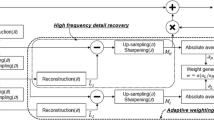Abstract
A single fast super-resolution method based on first-order derivatives from neighbor pixels is proposed. The basic idea of the proposed method is to exploit a first-order derivatives component of six edge directions around a missing pixel, followed by back projection to reduce noise estimated by the difference between simulated and observed images. Using first-order derivatives as a feature, the proposed method is expected to have low computational complexity, and it can theoretically reduce blur, blocking, and ringing artifacts in edge areas compared to previous methods. Experiments were conducted using 900 natural grayscale images from the USC-SIPI Database. We evaluated the proposed and previous methods using peak signal-to-noise ratio, structural similarity, feature similarity, and computation time. Experimental results indicate that the proposed method clearly outperforms other state-of-the-art algorithms such as fast curvature-based interpolation.









Similar content being viewed by others
References
Nuno-Maganda, M.A., Arias-Estrada, M.O.: Real-time fpga-based architecture for bicubic interpolation: an application for digital image scaling. In: International Conference on Reconfigurable Computing and FPGAs, 2005. ReConFig 2005, p. 8, 1 (Sept 2005)
Asuni, N., Giachetti, A.: Accuracy improvements and artifacts removal in edge based image interpolation. VISAPP (1)’08, pp. 58–65 (2008)
Liu, C., Sun, D.: A bayesian approach to adaptive video super resolution. In: IEEE Conference on Computer Vision and Pattern Recognition (CVPR) 2011, pp. 209–216. IEEE, (2011)
Takeda, H., Farsiu, S., Milanfar, P.: Kernel regression for image processing and reconstruction. IEEE Trans. Image Process. 16(2), 349–366 (2007)
Takeda, H., Milanfar, P., Protter, M., Elad, M.: Super-resolution without explicit subpixel motion estimation. IEEE Trans. Image Process. 18(9), 1958–1975 (2009)
Danielyan, A., Foi, A., Katkovnik, V., Egiazarian, K.: Image upsampling via spatially adaptive block-matching filtering. In: Signal Processing Conference, 2008 16th European, pp. 1–5. IEEE, (2008)
Yang, J., Wright, J., Huang, T.S., Ma, Y.: Image super-resolution via sparse representation. IEEE Trans. Image Process. 19(11), 2861–2873 (2010)
Mallat, S., Guoshen, Y.: Super-resolution with sparse mixing estimators. IEEE Trans. Image Process. 19(11), 2889–2900 (2010)
Demirel, H., Anbarjafari, G.: Discrete wavelet transform-based satellite image resolution enhancement. IEEE Trans. Geosci. Remote Sens. 49(6), 1997–2004 (2011)
Celik, T., Tjahjadi, T.: Image resolution enhancement using dual-tree complex wavelet transform. Geosci. Remote Sens. Lett. IEEE 7(3), 554–557 (2010)
Giachetti, A., Asuni, N.: Real time artifact-free image upscaling. IEEE Trans. Image Process. 20(10), 2760–2768 (2011)
Li, X., Orchard, M.T.: New edge-directed interpolation. IEEE Trans. Image Process. 10, 1521–1527 (2001)
Haris, M., Sawase, K., Widyanto, M.R., Nobuhara, H.: An efficient super resolution based on image dimensionality reduction using accumulative intensity gradient. J. Adv. Comput. Intell. Intell. Inform. 18(4), 518–528 (2014)
Zhang, L., Xiaolin, W.: An edge-guided image interpolation algorithm via directional filtering and data fusion. IEEE Trans. Image Process. 15(8), 2226–2238 (2006)
Irani, M., Peleg, S.: Motion analysis for image enhancement: resolution, occlusion, and transparency. J. Vis. Commun. Image Represent. 4(4), 324–335 (1993)
Wang, Z., Bovik, A.C., Sheikh, H.R., Simoncelli, E.P.: Image quality assessment: from error visibility to structural similarity. IEEE Trans. Image Process. 13(4), 600–612 (2004)
Zhang, L., Zhang, L., Mou, X., Zhang, D.: Fsim: a feature similarity index for image quality assessment. IEEE Trans. Image Process. 20(8), 2378–2386 (2011)
Acknowledgments
This work was supported by CREST, Japan Science and Technology Agency. We would like to thank the Indonesia Endowment Fund for Education (LPDP) Scholarships from the Ministry of Finance, The Republic of Indonesia for doctoral degree scholarship.
Author information
Authors and Affiliations
Corresponding author
Electronic supplementary material
Below is the link to the electronic supplementary material.
Rights and permissions
About this article
Cite this article
Haris, M., Widyanto, M.R. & Nobuhara, H. First-order derivative-based super-resolution. SIViP 11, 1–8 (2017). https://doi.org/10.1007/s11760-016-0880-y
Received:
Revised:
Accepted:
Published:
Issue Date:
DOI: https://doi.org/10.1007/s11760-016-0880-y




